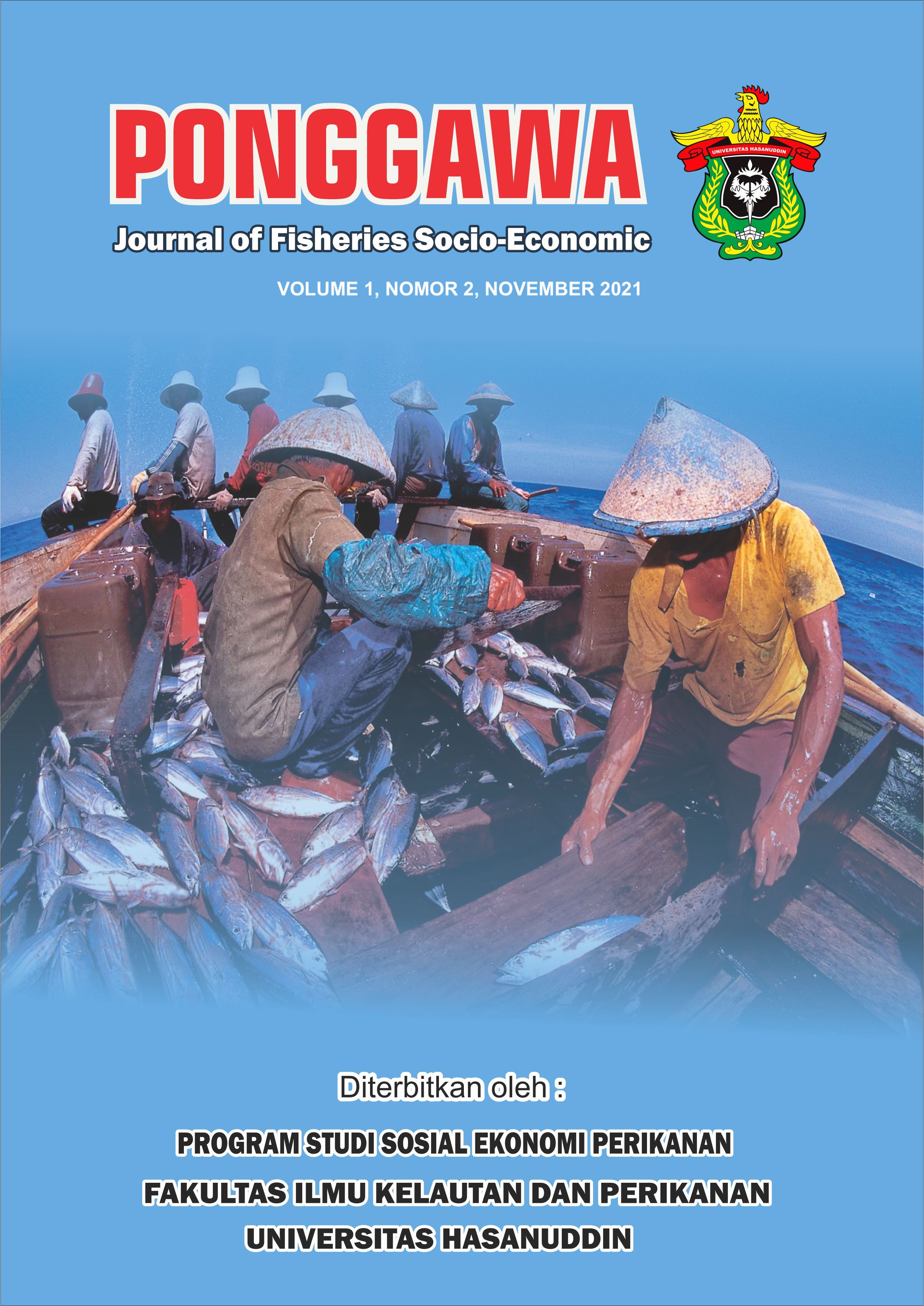Analysis of Online Learning Education Costs for Fisherman Children, Borimasunggu Village, Maros Regency
DOI:
https://doi.org/10.35911/ponggawa.v1i2.18426Keywords:
fishermen's children, respondent characteristics, online learningAbstract
This study aims to find out how much is incurred for the cost of education of fishermen's children before and during online learning and what percentage of spending is incurred on the education costs of fishermen's children from the total expenditure of fishermen's households. This research was carried out on December 10, 2020-11 Pktober 2021 in Borimasunggu Village of Maros Regency. The sampling method in this study was Purposive sampling. The data sources used are primary data and secondary data. Data analysis uses quantitative descriptive analysis by calculating the amount of income and expenditure by tabulating the data as well as the applicable analysis. Calculating the amount of fishermen's expenditure by summing up total food and non-food expenditures from before the pandemic and during the Covid-19 pandemic then analyzed the percentage of expenditures for education costs for fishermen's children with a percentage of 13.44% before the enactment of the online learning system and 7.25% during its enactment with learning methods used through gadgets with the WhatsApp application carried out by teachers to students who participated in activities. Learning to teach.
References
Andriani, H.B. 2013. Meredam Konflik Nelayan Melalui Diversifikasi Industri Rumah Tangga Nelayan Kota Parepare. Jurnal Academica Fisip Untad vol 5, no.1: 957-964
Arnesti, N., & Hamid, A. (2015). Penggunaan Media Pembelajaran Online – Offline Dan Komunikasi Interpersonal Terhadap Hasil Belajar Bahasa Inggris. Jurnal Teknologi Informasi & Komunikasi Dalam Pendidikan, 2(1). https://doi.org/10.24114/ jtikp. v2i1. 3284.
Basori, B. (2017). Efektifitas Komunikasi Pembelajaran Online Dengan Menggunakan Media E-Learning Pada Perkuliahan Body Otomotif. Jurnal Ilmiah Pendidikan Teknik Dan Kejuruan, 7(2), 39–45. https://doi.org/10.20961/jiptek.v7i2.12722.
Dewi, Wahyu, Aji, Fatma. 2020. Dampak Covid-19 Terhadap Implementasi Pembelajaran Daring di Sekolah Dasar. Salatiga. Universitas Kristen Satya Wacana. Edukatif: Jurnal Ilmu Pendidikan Volume 2 Nomor 1 April 2020 Halm 55-61.
Dhika Wiratama, Azhar. 2021. Model Ekonomi Rumah Tangga Petani (Kasus Kecamatan Bogor Barat, Kota Bogor). Skripsi. Fakultas Sains dan Teknologi Universitas Islam Negeri Syarif Hidayatullah: Jakarta
Fakhriyyah, S., Hasani, M.C & Astuti, A. 2016. Analisis Rumah Tangga Nelayan Mini Purse Seine di Kecamatan Bontobahari Kabupaten Bulukumba. Jurnal Bisnis Perikanan FPIK UHO vol 3, no.2: 117-126.
Isnaniah, Syofyan Irwandy, & Armansyah Doni. 2013. Identifikasi dan Analisis Alat Tangkap Jaring Kurau yang Digunakan Nelayan di Perairan Kabupaten Bengkalis. SSN 0126 – 4265 Vol. 41. No.2. Berkala Perikanan Terubuk, Juli 2013, hlm 32 – 39
Kharisun, Muhammad. 2014. Karakteristik Dan Peran Istri Nelayan Dalam Pendapatan Keluarga Nelayan di Kota Pekalongan. Semarang. Universitas Diponegoro.
Kusnadi. 2017. Analisis Tingkat Kesejahteraan Rumah Tangga Nelayan Berdasarkan Nilai Tukar (NTN) di Kampung Sowi IV Kabupaten Monokwari. The Journal of Fisheries Development vol 2, no.2:45-54.
Lampe, M. 2015. Punggawa-Sawi Nelayan Bugis-Makassar Dalam Analisis Relasi Internal dan Eksternal. Jurnal Masyarakat dan Budaya vol 17, no.1: 77-88.
Maldini, F.Y. (2013). Hubungan Antara Tingkat Pendidikan dan Sosial Ekonomi Nelayan Terhadap Ketuntasan Wajb Belajar 9 Tahun Anak di Kelurahan Bandarharjo Kecamatan Semarang Utara. Skripsi.Universitas Negeri Semarang.
Nurhayati. 2020. Metode Pembelajaran Daring/E-learning Yang Efektif. Bali: Universitas Ganesha Singaraja.
Pertiwi, Rindhi Udiah. 2016. Analisis Konsumsi Pangan dan Non Pangan Karyawan Pelaksana PTPN IV Kebun Bahbutong Kabupaten Simalungun. Jurnal. Program Studi Agribisnis Fakultas Pertanian Universitas Sumatera Utara. Medan
Pramana, dkk. 2017. Pengaruh Faktor Ekonomi, Sosial dan Demografi Terhadap Pendidikan Anak Nelayan di Kabupaten Badung. PIRAMIDA Vol. XIII No. 1 : 51-58.
Ramadhan, A., Yuliati, C & Koeshendrajana, S. 2017. Indeks Sosial Ekonomi Rumah Tangga Nelayan Indonesia. Jurnal Sosial Ekonomi Kelautan Perikanan vol 12, no.2: 235-253.
Republik Indonesia. 2013. UU No. 20 Tahun 2013 Tentang Sistem Pendidikan Nasional.
Soekartawi. 2003. Teori Ekonomi Produksi. PT Raja Grafindo Persada. Jakarta. 247 p.
Sriwihajriyah, N;, Ruskan, E. L.;, & Ibrahim, A. (2012). Sistem pembelajaran dengan e-learning untuk persiapan ujian nasional pada SMA Pusri Palembang. Jurnal Sistem Informasi (JSI), 4(1), 450–449.
Sugihartono, dkk. 2012. Psikologi Pendidikan. Yogyakarta: UNY Press.
Suryaningsi, T. 2017. Kemiskinan Masyarakat Nelayan di Desa Aeng Batu-Batu Kabupaten Takalar Sulawesi Selatan. Handep vol 1, no.1: 49-62.
Utami, Jana Putri. 2017. Pengeluaran Konsumsi Pangan dan Non Pangan Rumah Tangga di Kota Medan dan Faktor yang Mempengaruhinya. Tesis. Program Studi Magister Agribisnis Fakultas Pertanian Universitas Sumatera Utara. Medan
Wuryandari, Ratna Dewi. 2015. Faktor-Faktor yang Mempengaruhi Pengeluaran Makanan, Pendidikan, dan Kesehatan Rumah Tangga Indonesia. Jurnal Kependudukan Indonesia | Vol. 10 No. 1 Juni 2015 | 27-42.








